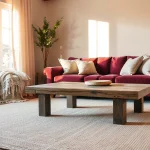Understanding High-Quality Building Materials
High-quality building materials are crucial in construction projects, defining a standard for safety, efficacy, and long-term value. But what makes a material “high-quality”? These materials generally feature superior durability, resistance to environmental stressors, and compliance with stringent construction standards. For example, materials like reinforced steel or treated wood are highly regarded for their strength and longevity, offering consistent performance over time.
The benefits of using quality materials go beyond mere strength. They often reduce future costs by lowering maintenance needs and increasing the lifespan of infrastructure. This leads us to a comparison: while high-quality materials might initially incur higher expenses, the long-term savings often outweigh these costs, as low-quality alternatives may require frequent repairs or replacements.
Additional reading : Game-changing innovations enhancing security in high-rise residential buildings
A prevalent misconception exists regarding building costs: many believe premium materials unnecessarily inflate budgets. However, investing in high-grade options often proves more economical by preventing issues and enhancing property value.
Choosing the right materials isn’t just about adhering to basic regulations—it’s about securing a project’s future and ensuring safety and reliability for all involved.
Topic to read : Telecommuting revolution: transforming suburban real estate dynamics and market insights
Durability and Longevity
The importance of durability in construction projects cannot be overstated. Durable materials ensure structures withstand various environmental factors, which translates into minimal repairs and maintenance over time. This not only supports safer living environments but also enhances property value.
Numerous case studies highlight the impressive lifespan of quality materials. For instance, high-grade steel and reinforced concrete demonstrate exceptional longevity, retaining structural integrity even after decades of use. Such materials have proven their worth in both historical edifices and modern designs, showcasing the necessity of investing in robust construction components.
Investing in durable options offers long-term cost savings. While initial expenditures might seem higher, the reduced need for frequent replacements and repairs ultimately offsets these costs. A focus on longevity also aligns with sustainable practices by minimizing resource consumption and waste generation.
Moreover, choosing high-quality materials is a practical approach that supports economic efficiency. Constructors and developers benefit from extended build life, enhancing their projects’ market appeal. Embracing durability is a strategic decision, offering not only peace of mind but also long-term economic benefits for all stakeholders involved.
Cost-Effectiveness Over Time
Evaluating the cost-effectiveness of purchasing robot hoovers necessitates a comprehensive understanding of the financial benefits over the lifespan of the device. Initially, the upfront costs may appear substantial, yet the potential for long-term savings often justifies this expenditure. This is achieved through reduced manual labour and energy efficiency.
Financial Benefits of High-Quality Materials
Robot hoovers crafted from high-quality materials often require less maintenance and incur lower repair expenses. These devices are designed to be durable, thus minimising the likelihood of damage or breakdowns that could lead to unexpected costs. Over time, the lifecycle costs of a durable hoover are likely to be lower compared to less robust alternatives.
Expert Insights on Budgeting
When budgeting for a robot hoover, it’s critical to account for the overall lifecycle costs rather than merely the initial price. Experts recommend allocating funds for a product with durable materials, as the upfront investment often translates into modest ongoing expenses. This strategic approach can ensure that the device offers maximum financial benefits and remains a cost-effective solution throughout its use.
By prioritising high-quality materials, consumers can optimise their budget and enjoy the enduring financial advantages of a robust robot hoover.
Aesthetic Appeal
In recent years, aesthetic value has become increasingly important in architectural design. The design quality is heavily influenced by the choice and use of quality materials. These materials not only improve the structural integrity but also greatly enhance the visual appeal of a project. For instance, using polished marble or sustainably sourced wood can transform an interior from mundane to magnificent.
One striking example is in urban renovations, where modern buildings incorporate high-quality glass panels. Such materials accentuate aesthetic value by allowing for more light and creating transparent, open spaces. This transparency trend aligns with the public’s desire for connectivity with nature and surroundings.
Moreover, trends in architectural design consistently show a shift towards natural and durable materials. This preference underlines the importance placed on both the design quality and the sustainability of structures. Organic textures, like exposed concrete or corten steel, have surged in popularity, praised for their raw beauty and minimal maintenance.
Quality materials, when skillfully used in design, not only satisfy functional needs but also elevate the visual appeal significantly. They foster a connection between the architectural piece and its environment, enhancing the user’s experience and fulfilment.
Environmental Sustainability
Sustainability is a fundamental aspect of modern construction practices. The use of eco-friendly materials plays a significant role in reducing the environmental impact of buildings. High-quality materials are pivotal, ensuring durability and efficiency while minimising resource consumption.
In terms of environmental impact, there is a stark contrast between high-quality and low-quality materials. Quality materials typically result in buildings that require less maintenance and have longer lifespans, thereby reducing waste and the need for resource-intensive repairs. In contrast, low-quality materials often lead to frequent replacements and resource depletion, significantly harming the environment.
Certifications and standards for eco-friendly building materials offer guidance and assurance in sustainable construction. These certifications, such as LEED and BREEAM, ensure that materials meet rigorous environmental criteria. They focus on various factors, including energy efficiency, resource optimization, and reduction of harmful emissions. Such standards are crucial for promoting sustainability in the construction sector.
High-quality materials, backed by recognised certifications, play an essential role in the broader context of environmental sustainability. They help in reducing the carbon footprint of buildings and contribute substantially to a more sustainable future.
Real-Life Examples and Case Studies
Exploring real-life examples provides insightful perspectives on the benefits of high-quality building materials. Notable projects around the world have showcased the profound impact that these materials can have on construction outcomes. These examples highlight how strategic choices in materials contribute to not only structural integrity but also aesthetic appeal and sustainability.
One remarkable case study is the construction of the Museum of Modern Art in Mexico City, where premium materials were crucial for both durability and design. The architects prioritized sustainable materials, which enhanced the building’s eco-friendliness while maintaining its modern aesthetic.
In another instance, a residential project in Sweden demonstrated how the use of high-grade insulation materials dramatically reduced energy costs. This project has served as an inspiration for homeowners striving to create more energy-efficient homes.
Testimonials from builders and homeowners emphasize the transformative experience of using quality materials. Homeowners frequently report increased satisfaction with the longevity and performance of their homes. Builders note that high-quality materials are essential for meeting client expectations and achieving exceptional results in construction projects.
These case studies and testimonials underline the practicality and significance of selecting superior building materials to achieve desired outcomes in construction.
Conclusion and Recommendations
Selecting the appropriate building materials is fundamental to the success of any construction project. Making informed choices requires a comprehensive understanding of the materials’ characteristics, costs, and performance capabilities. When deciding on materials, it’s crucial to consider their durability, sustainability, and how they align with the project’s goals.
To make informed decisions, conduct thorough research and consult reliable sources to gather evidence about material properties and suitability. Evaluate not only initial costs but also long-term implications, like maintenance and sustainability. Ask questions like, “How will this material withstand environmental conditions over time?” and “Is it sourced sustainably?”
Adopting best practices for material selection involves prioritizing quality over cost-cutting. Choose materials that comply with industry standards and have proven performance records. Look for certifications that assure quality, as these can be indicators of reliability and safety.
A commitment to quality in construction projects encourages a focus on durability and efficiency. This not only enhances the lifespan of the structure but also ensures safety and environmental responsibility. By making informed choices, stakeholders can achieve their objectives and contribute positively to the integrity of the built environment.










